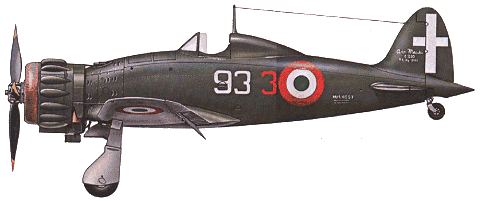|
| Handicapped by Italy's pre-war lack of
a powerful engine suitable for fighters,
Mario Castoldi's radial-powered Fiat
C.200 was so underpowered and
undergunned that when it arrived in
service in 1939 it was already outclassed
by the Hawker Hurricane which
had joined the RAF two years earlier.
Indeed the first C.200 unit, the 4° Stormo,
expressed a preference for the
CR.42 and accordingly reverted to the
biplane in 1940. First flown on 24 December
1937 by Giuseppe Burei, the
C.200, named the Saetta (lightning),
went on to equip the 1°, 2°, 3°, 4° (in
mid-1941) and 54° Stormi, and the 8°,
12°, 13°, 21" and 22° Gruppi, a total of
about 1,200 aircraft being produced by
Macchi, Breda and SAI Ambrosini. On
the date that Italy entered the war, 10
June 1940, two home-based stormi
were combat-ready with the C.200,
being first flown in action over Malta in
September that year, and it was largely
the losses suffered by the Italian
fighter arm at this time and during the
Greek campaign that prompted the
Luftwaffe to deploy X Fliegerkorps in
the Mediterranean to bolster the Regia
Aeronautica's flagging resources.
C.200s were heavily committed in
North Africa, and were fairly evenly
matched with the early Hurricane Mk.Is, weighed down by tropical air filters,
but the attrition suffered by all Italian
air force units (principally through
poor serviceability and air attacks on
their airfields) quickly reduced the
number of C.200s. Some 51 Saettas of
the 22° Gruppo operated in the Odessa
zone of the Eastern Front from August
1941 onwards, proving capable of
matching the older Soviet fighters in
the early stages of that campaign. By
the time of the Italian armistice in
September 1943, however, the Regia
Aeronautica's total inventory of serviceable
C.200s stood at only 33.

| CREW | 1 |
| ENGINE | 1 x FIAT A-74 RC-38, 620kW |
| WEIGHTS |
| Take-off weight | 2533 kg | 5584 lb |
| Empty weight | 2014 kg | 4440 lb |
| DIMENSIONS |
| Wingspan | 10.6 m | 35 ft 9 in |
| Length | 8.2 m | 27 ft 11 in |
| Height | 3.5 m | 12 ft 6 in |
| Wing area | 16.8 m2 | 180.83 sq ft |
| PERFORMANCE |
| Max. speed | 503 km/h | 313 mph |
| Cruise speed | 455 km/h | 283 mph |
| Ceiling | 8900 m | 29200 ft |
| ARMAMENT | 2 x 12.7mm machine-guns |
 | A three-view drawing (1685 x 1260) |
| ubaTaeCJ, e-mail, 21.02.2025 16:48 20 reply | | GrahamClayton, e-mail, 06.03.2024 02:33 The distinctive “bubbles” on the engine cowling protected the rocker arms of the cylinders. reply |
| paolo schiavon, e-mail, 03.02.2024 00:24 don't know who wrote this article on the Macchi 200, but I don't find him in good faith, or in any case ill-informed and ungenerous in describing the characteristics of this Macchi which gave rise to and handed down its qualities to the formidable 202 Folgore which obtained a rate of kills / losses equal to the Spitfire V, much more armed and more powerful with an engine, but not as effective as the Folgore in terms of the number of Spitfire Vs used and present in the clashes. against the Folgore 202. If this happened it was also thanks to the excellent base of this Macchi 200 Saetta.
I observe, in contradiction to what the article above states:
1 it does not appear that the Hurricane was superior to the Macchi 200, in fact it appears the opposite: The Macchi 200 was superior in combat to both the Hurricane and the Curtiss P40 in the air battles that occurred in North Africa.
2 An English pilot officer who tested a Saetta found intact at an airport near Tripoli, compared it in a simulated combat with Curtiss P40, Hurricane and Spitfire, and the Macchi 200 turned tighter even than the Spitfire, and despite its 860 hp radial engine against the 1300 hp of its adversaries, it had a speed not much lower than the Hurricane, but its agility was clearly superior to the Hawker, which would certainly suffer from its inferior maneuverability if it had accepted a fight with the Saetta On the other hand, it was a common opinion among the pilots of the Regia Aeronautica that the Saetta could also duel with the spitfires and come out undefeated, as long as the Englishman did not present himself in a condition of numerical superiority, something quite frequent, which is often kept quiet by historians. Anglo-Saxons who today explain to us poorly and incorrectly what plane the Saetta was.
3 The ace Captain Gorrini who brought to Italy about forty French Dewoitine fighters of D520 war prizes, considered in 1940 the best fighters available to the French air force, and who also knew the Saetta well, because it was the fighter he piloted , said that the Saetta was certainly superior to the Dewoitine D520, the best French fighter, even though the latter had the advantage of being armed with a 20 mm cannon.
4 The airframe of the Macchi 200 Saetta was so good that the Macchi mc 202 Folgore quickly derived from it, which was an exceptional aircraft, a Killer that shot down many more powerful and much more armed Allied fighter planes, including include Spitfire V and P38 Lightning, often encountered in numerical inferiority (3 or more against 1
and using only two 12.7 mm Breda Safat machine guns like the Saetta, against opponents equipped with 4 20 mm cannons like the Spitfire V)
5 It is common opinion that both the Macchi 202 Folgore and the Reggiane Re 2001, the former derived from this Macchi 200, changing the Fiat radial engine into the Alfa Romeo in-line engine licensed by DB, and the Re 2001 derived instead from the previous Reggiane 2000 fighter, if had arrived at the end of 1940 and had been immediately armed with a single 20 mm cannon on the propeller hub like the Me 109, which was not possible because it would have taken too much time to recalculate and redesign the airframe of such aircraft, and the times of the war did not allow him to waste too much time, the losses of aircraft suffered by the RAF, which already at the end of 1940 had 20 mm guns, such as Hurricane Mk II and Spitfire V., would certainly have been far greater.
​
Paolo Schiavon reply | | Barry, 12.02.2013 13:41 Mario Castoldi had enough experience from designing and building his record breaking sea plane, the MC72, to realise the benefits of in line engines at that time. However, as Italian engine manufacturers had been instructed to concerntrate on radial engines the Saetta was powered by the wholely inadequate Fiat A.74 RC.38. It wasn't untill the coming of the very much improved MC202 and MC205V with the Alfa Romeo RC41 Mosone and Fiat RA.1050 RC58 Tifone respectively that Castoldi got what he wanted and the Italians got what they needed. As for the open cockpit, that was down to the rather conservative nature of the pilots of the "Regia Aeronautica". reply |
|
| | Malcolm, e-mail, 02.08.2011 13:43 There's a certain rugged beauty about this fighter. I was first negatively attracted to it for its aerodynamic uggliness compared with contemporary fighters like Spitfire and FW 190 etc. But the more I study it the more I am attracted to it. I'm going to model it from corrugated cardboard. Length approx 400mm. reply | | Klaatu, e-mail, 09.06.2011 03:42 As mentioned above, the British first encountered these fighters in 1940 over Malta. At that time, the total RAF fighter strength on Malta consisted of three (3) Gloster Gladiator biplane fighters. According to the British accounts, the Gladiators had more trouble dealing with the Fiat Cr-42 biplane fighters they encountered than they did with these monoplanes! reply | | condor, e-mail, 03.12.2009 19:46 I´m buildg a r /c model of this plane on a scale of 1:5.2 and it as been quite a challenge.I´m making everything except motor and electronics. The landing gear and the cooling flaps were a tought treat. Does anyone have pics. of the Breda Saffat 12.7 mm so I can reproduce them for my scale model airplane? reply | | Ronald, e-mail, 11.09.2009 10:37 The MC 200 Saetta had twin Breda-SAFAT 12.7 mm synchronized cowl guns firing 575 r /m (per gun. Not bad for a Browning). 370 rounds of ammo per gun was a decent supply. Late model versions also had 7.7 mm wing guns with a firing rate of 810 r /m ave, with 500 rounds of ammo per gun.
This carried through to the MC 202 Folgore. It was considered under-armed by then (replace the 7.7 mm with at least 2 more 12.7 mm MGs already!). reply | | Ronald, e-mail, 30.08.2009 20:01 It's easy to forget that many pilots were still loyal to the open cockpit biplanes early in the war. As late as 1940 the U.S. N. flew the F3F biplane. So the Macchi C 200 doesn't seem so bad if you remember it was surrounded by Fiat biplanes. It compares favorably with the Fiat G 50 Freccia monoplane.
Saettas climbed to 6km in 7.55 minutes; 5km took 5.86 minutes. Dive speed was in the 500 mph class! reply | | Thomas De Moor, e-mail, 28.06.2009 06:50 Hello
Sorry but your description of my favourite plane of the second war is so negative...I recognise i like it more because of its design than because of its performances,but for a 620kw enginered plane its speed or climbing rate is not so bad,no? I try it on the Il-2 stormovic fly simulator and I found it very nice to pilot.It climbs very well,turns correctly and its breda saffat are very accurate.The fighter is stable but for diving you have to reverse the plane on its back first,otherwise the engine stop,i dont know why.I expect Italian pilots should have appreciated its wonderfull shape,its high personnality and the open canopy they were asking for so desperately...I also liked its strage collimator and the inboard instuments.You have a perfect view in front of you from the cokpit and the oil tank seems to be corectly armoured against allies machineguns (up to .50) Finally I want to add that its little brother,the c 205 Veltro,with two breda saffat,two mg 151 and a me 109 g engine,seems to be one of the best fighter of the axe,maybe better than the latest mass produced messerchmits g.
I dont want to rewrite the war again,and I dont care of politics but I'm sure if the Italian have had more of these fighters,better maintenance meens and military stuctures,the little saetta could have desearved the respect of its rivals and ennemies...
So,thank you for your web site,see you.
Thomas reply | | Leo Rudnicki, e-mail, 05.06.2009 23:57 Mario Castoldi, who designed the MC-72, was the designer. The open cockpit and the engine were not his choice, or his fault. It's the same aircraft as the Folgore, more or less. Designers don't choose armament either. And the 1935 Me 109 wasn't that hot. reply | | Stratomunchkin, 05.06.2009 16:49 How anyone could design a plane with such lousy specifics by 1937 and then have *another* moron even hand out government contracts for it is way beyond me. The Me Bf 109 flew with better characteristics in 1935, for heaven's sake! reply |
|
Do you have any comments?
|
| 
COMPANY
PROFILE
All the World's Rotorcraft
|




 Stratomunchkin
Stratomunchkin




20
reply